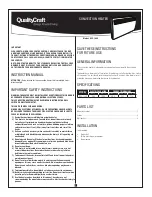
SCWD-QS (12/16)
Page 53
2) System
Problem /
Symptom
Likely Cause(s)
Action/Correction
A. System does
not run.
Note: Some digital
thermostats
have a built-in
five-minute time
delay
.
1. Thermostat fault.
1. Adjust thermostat settings. / Replace thermostat.
2. Power supply problem (AHU /
compressor unit).
2. Check power supply for adequate phase and
voltage. Check wiring to system and external
breakers or fuses.
3. Control voltage problem.
3. Check for 24V on terminal strip between R and C
terminals.
4. Shut off by external thermostat
or thermostat is defective.
4. Check operation of thermostat.
5. System lockout: System off on
high pressure / low pressure
switches or discharge
temperature switch.
5. Reset limit switch. Analyze system for root
cause. Check between Common and X terminal
for 24V, indicating a lock-out condition. Reset if
necessary by disabling the unit 24V control
power momentarily.
6. Internal component or
connection failure.
6. Check for loose wiring. Check components for
failure.
7. Compressor contactor not
pulling in.
7. Check for 24V across contactor. Trace 24V
circuit and components between “Y” and “C” to
locate fault. Repair or replace as necessary.
8. Faulty run capacitor or start
components.
8. Test each and replace as necessary.
9. Compressor windings shorted or
grounded.
9. See compressor diagram/ replace the
compressor. Replace filter drier and run
capacitor.
10. SureStart fault
10. Check the SureStart to see if the red LED is
flashing. Flashing codes are in section
“Installation – 7) SureStart
” of this manual.
11. Nano-PLC fault
11. With thermostat calling, verify the inputs and
outputs of the Nano- PLC following the wiring
diagram. Contact tech support
B. System runs for
long period or
continuously.
1. Thermostat fault.
1. Adjust thermostat settings / Replace thermostat.
2. Refrigerant undercharged.
2. Repair leak and replace filter drier. Evacuate
and recharge system.
3. Component failure.
3. Check pressures and electrical circuits for
abnormalities.
4. Outdoor thermostat not
connected or failed (heating
mode).
4. Check outdoor thermostat and electric
supplemental heat operation. Confirm proper
wiring.
5. Reduced air flow.
5. Check air ducts for leaks and repair. Check
blower operation. Check air filter(s). Remove air
flow restrictions (min.400 CFM/ton).
6. Four-way reversing valve is
short circuiting refrigerant and
bypassing hot gas to suction.
6. Replace four-way reversing valve and filter drier,
evacuate, recharge and start-up system.
7. Unit undersized.
7. Contact ETI Technical Support at 863-701-0096.
C. System blows
fuses or trips
circuit breaker.
1. Inadequate circuit ampacity.
1. Note electrical requirement and correct as
necessary.
2. Short, loose or improper
connection in field wiring.
2. Check field wiring for problems.
Figure 35. System Troubleshooting Chart
Summary of Contents for SCWD-024-1C
Page 15: ...SCWD QS 12 16 Page 15 Figure 7 SCWD Compressor Unit Electrical Schematic Diagram 230 1 60...
Page 16: ...SCWD QS 12 16 Page 16 Figure 8 SCWD Compressor Unit Electrical Schematic Diagram 230 3 60...
Page 17: ...SCWD QS 12 16 Page 17 Figure 9 SCWD Hydronic Heating Cooling Water Heating Sytem Application...
Page 20: ...SCWD QS 12 16 Page 20 Figure 11 SureStart Mode of Operation...
Page 31: ...SCWD QS 12 16 Page 31 Figure 14 Disassembled Plug Connector...
Page 38: ...SCWD QS 12 16 Page 38 Figure 23 SCWD Internal Flow Schematic...
Page 39: ...SCWD QS 12 16 Page 39 Figure 24 SCWD Piping...
Page 41: ...SCWD QS 12 16 Page 41 Figure 25 Evacuation of SCWD System...
Page 43: ...SCWD QS 12 16 Page 43 Figure 26 Initial Charge of SCWD System...
Page 45: ...SCWD QS 12 16 Page 45 Figure 27 Final Charge of SCWD System...
Page 48: ...SCWD QS 12 16 Page 48 Figure 31 Start Up Process...










































